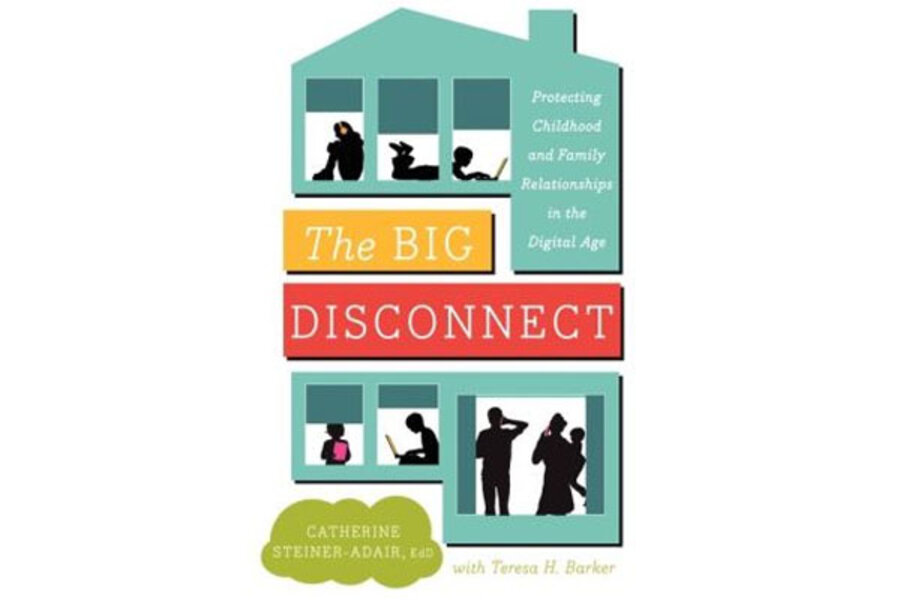The Big Disconnect
Loading...
First it was TV, then it was video games that were poised to transform each new generation of children into shallow, superficial brutes. Now we’ve added the Internet – a pervasive minefield of unrestricted content that makes those old threats seem downright quaint.
Many of us have reacted by sticking our heads in the sand and hoping: Our kids would turn out fine; our daughters were not worshipping at the altar of thinness; a little “gorenography” (violent porn) wouldn’t sabotage our sons’ healthy sexual development.
In The Big Disconnect: Protecting Childhood and Family Relationships in the Digital Age, author Catherine Steiner-Adair yanks our brains from sandy oblivion and proves it’s our duty as parents not just to keep our eyes open, but to ensure our children go through the slow, often difficult developmental steps crucial to becoming healthy, well-adjusted, authentic adults.
Do your kids a favor and read this important book. Steiner-Adair, a Boston-area clinical psychologist, media consultant, and former high-school counselor, draws from myriad real-life examples of how tech has disrupted, even debilitated, children’s lives. Keeping your head in the sand, you’ll discover, is nothing short of neglect.
Think your child is somehow protected? In clear, gentle prose, Steiner-Adair firmly shoots down every excuse parents give for claiming to be irrelevant to their child’s screen life.
You’ve installed parental controls on her TV? "Gossip Girl" is teaching her that snarky is the norm for girls, and looks matter more than anything. You refuse to buy violent video games? Your son is playing them at his friend’s house. Your kids don’t even have a smartphone? They’re exposed to violence and sex on someone else’s. They open emails only from trusted friends? Those young friends might not realize what they’re passing along, like that explicit YouTube video sent by a 5th-grade boy to a female classmate, which caused the girl months of debilitating anxiety.
If all this worry over the effects of TV and gaming sounds familiar – after all, we watched violent cartoons and turned out all right – Steiner-Adair reminds us: In the 1960s and 70s, TVs didn’t follow us out the door.
Children as young as six arrive in her office, shaken by what they’ve seen: violent TV news in airport waiting areas; mean messages posted on Facebook; disturbing sexual images accidentally opened on an iPhone. The “magic of the iPad” has replaced the magic of the playground. Today’s children, says Steiner-Adair, are “in over their heads and they need adult help.”
Nor is it simply what our children are exposed to. Equally troubling is what these plugged-in kids are not learning: critical steps in the development process such as empathy, negotiating skills, impulse control, sustained attention, and the capacity to be alone and connect with oneself. She laments the loss of boredom – which this plugged-in generation seldom feels – as the critical first step to creativity.
And yet, as busy parents wanting to quell their complaints from the mini-van carpool, we hand them an iPhone game. What we don’t realize is by making it easy on ourselves, we’re making it harder on our children: Those rapid-tap games are rewiring their brains for fast-twitch thinking, which may lead to helpful multi-tasking (surfing the Net while writing a paper), but also to careless multi-tasking (texting while driving).
In the chapter on 3- to 5-year-olds, “Mary Had A Little iPad,” Steiner-Adair illustrates precisely what a child misses when tech replaces play. Four-year-old Alissa says her favorite game is “dress-up,” which she plays after school – on the family iPad. Alissa’s “little index finger darts expertly from space to space as she selects items and colors. Tiara or barrette? Tap! Stiletto heels or peek-toe pumps? Tap!” (Even before this game can begin, Alissa had to watch ads for detergent and allergy medication.)
For Steiner-Adair, this is not “playing dress-up” at all. Rather, real dress-up involves digging through a box of old clothes; feeling and smelling the fabrics; finding one shoe and not the other, and then turning disappointment into a creative solution; inviting a friend and having to negotiate who gets to wear the only tiara; tattling to your mother and being heard; and all the while telling yourself stories, imagining yourself as a princess, with that old couch your castle.
These actual moments of play, Steiner-Adair says, “stretch creativity and develop imaginations. They deepen your capacity to learn and to keep learning, taking you on to new developmental challenges and growth.”
What’s a family to do? The author’s final chapter, “The Sustainable Family,” presents practical guidelines, among them: Declaring a family philosophy; providing non-tech activities you do together; keeping communication open, even though it means having awkward conversations about topics you never had the occasion (or need) to discuss with your own parents.
So unplug from your own tech distraction, pick up this book, and read. Learn what our children are actually doing on today’s plugged-in playground. Decide right now: What kind of childhood do I want for her? What kind of skills will make him a caring, loving adult, and how can I teach, and reinforce, those skills?
It starts at home. Listen to what one tech-savvy teenager said: “I think in the olden days families mattered more. It feels like we’re losing the idea that family matters.”








